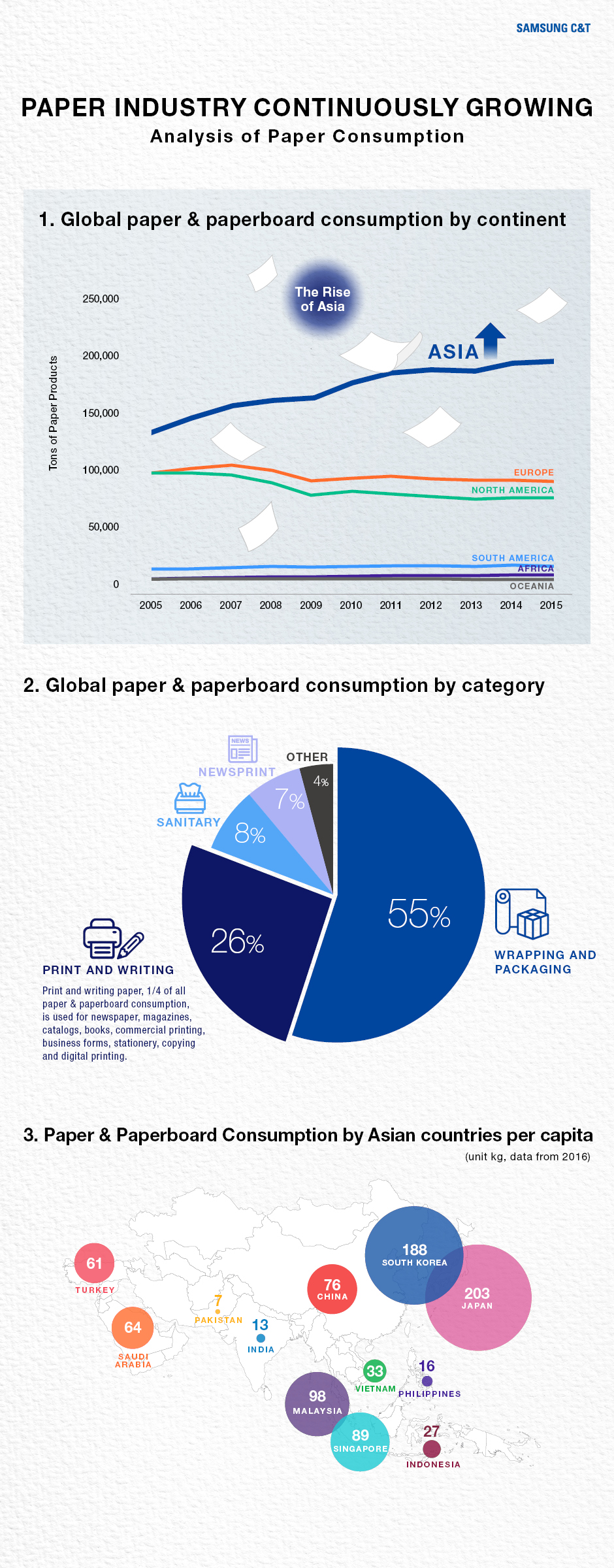It may have been invented over 2,000 years ago, but paper is a material that has stood the test of time. In fact, it remains deeply involved and used in our daily lives.
Although it comes in many different forms such as A4, coated paper, and paperboard, and production methods have evolved since the Industrial Revolution of the 19th century, people still make paper according to the fundamental principles developed in China over two millennia ago. Basically, paper sheets are made from the cellulose fibers of wood. These fibers stick together after being mixed with water and then dried through pressure and heat.
Until the late 20th century and the dawn of the Digital Revolution, paper was almost the only way to share information such as news, literature and messages. But the arrival of computers in the 1970s caused people to start predicting a paperless world.
The exaggerated death of paper
Over a decade ago, The Economist commented: “Reports of the death of paper, rampant in the 1990s, were evidently greatly exaggerated.” In fact, in the 21st century, despite the popularity of PCs and mobile phones, paper is more popular than ever.
Over the last 50 years, paper use has quadrupled, according to the Environmental Paper Network. Published in 2018, its report “The State of the Global Paper Industry” reports that annual global paper production reached close to 400 million tons for the first time in 2014, and is set to hit 490 million tons by 2020. Assuming a global population of eight billion, this equates to annual consumption per capita of around 60kg (across all applications, including packaging, printing paper and hygiene).
Even looking at printing paper alone, its future continues to look bright – with Transparency Market Research forecasting steady compound growth of 4.9% from 2018 to 2028.
Diverging paper demand patterns
A closer examination of paper industry trends shows a gap between Asia and the rest of the world. While Asia’s paper demand is on the rise, the industry’s overall recent pattern demonstrates that North America and Europe are consuming fewer paper products.
East Asia is an interesting example because Japan and South Korea each used more than double the global average per capita of paper in 2018 – even though Japan is consuming less of it each year, while South Korea’s paper consumption is still growing slightly.
Meanwhile emerging markets like China and India are enjoying a paper boom, maintaining the industry’s status as a large and growing portion of the world economy. China alone consumes more paper than North America, South America, and Europe combined, and it is showing a slight increase in demand over time. Moreover, India’s printing and writing paper segment is set to expand at a CAGR of 4.2 percent in 2020 due to better literacy rates and an increase in school and college students and this point underscores the role of new markets driven by the middle class in emerging economies.
Samsung C&T Trading Group has established an active role in supplying A4 paper to Southeast Asia, as the industry continues to perform well in the region’s key developing markets. For instance, Vietnam’s domestic consumption of printing and writing paper is estimated to still grow by about 3-5% in 2019.
Paper industry active in innovation
Aside from external factors and market forces, the industry itself is also working hard to stay relevant. Technological advancements and eco-friendly production methods and encouraged trends have all contributed to paper’s endurance.
Thermal printers are faster, more durable, and cheaper than other printing methods, and they can even print in color now. The overall industry is predicted to grow at 5.0% CAGR from 2018 to 2023, mostly due to the retail sector. There has also been a technological jump in anti-copy paper production, including legal documents, paper money, certificates, passports, stamps and ID cards. Also known as security paper, the anti-copy paper industry is expanding at an expected 5.42% CAGR from 2018 to 2023.
Meanwhile, the environmental benefits of paper have allowed the industry to push paper as an eco-friendly alternative to plastic in packaging common household goods. It is even argued by industry advocates that the paper industry has helped the environment due to the planting of more trees. The vast majority of wood fibers used to make paper and paperboard come from tree plantations, and the trees there would not have been planted without the paper industry as a motivation. Going even further, general trading companies such as Samsung C&T and global paper manufacturers like to explore plastic packaging alternatives along with biodegradable new material technology.
Thriving in Digital Age
In the 21st century, when computers, smartphones, and even plastics have been more widely adopted, paper is still cherished thanks to its hidden advantages.
Several studies have indicated that paper remains an excellent education medium. For instance, a 2016 study of European and Asian students found that many of them prefer to physically write on paper, as handwriting helps to learn and retain knowledge. Just reading off paper rather than a screen allows students to understand words better too, according to a Norwegian study of 10th graders – apparently because paper enables pupils to create a more effective mental map of information.
So, due to external factors, market forces, industrial efforts and its hidden strengths mentioned earlier, paper is getting more popular than ever. And it isn’t going anywhere.










